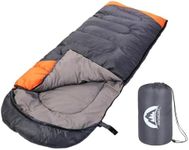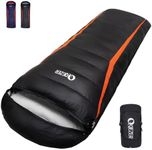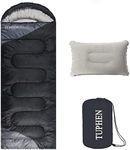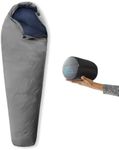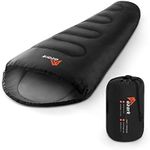Buying Guide for the Best Ultra Compact Sleeping Bag
Choosing the right ultra-compact sleeping bag is crucial for ensuring a comfortable and restful sleep during your outdoor adventures. These sleeping bags are designed to be lightweight and easy to pack, making them ideal for backpackers, hikers, and travelers who need to save space and weight. When selecting an ultra-compact sleeping bag, consider the climate and conditions you'll be facing, as well as your personal comfort preferences. Understanding the key specifications will help you make an informed decision that best suits your needs.Temperature RatingThe temperature rating of a sleeping bag indicates the lowest temperature at which the bag will keep the average sleeper warm. This is important because it helps you choose a sleeping bag that will keep you comfortable in the conditions you expect to encounter. Temperature ratings are usually divided into three categories: summer (above 35°F or 2°C), 3-season (10°F to 35°F or -12°C to 2°C), and winter (below 10°F or -12°C). Consider the coldest temperature you expect to face and choose a bag with a rating slightly lower than that to ensure warmth.
WeightWeight is a critical factor for ultra-compact sleeping bags, especially if you're backpacking or hiking. A lighter sleeping bag is easier to carry over long distances. Sleeping bags can range from under 1 pound (0.45 kg) for the lightest models to over 3 pounds (1.36 kg) for more insulated options. If you're planning a long trek, prioritize a lighter bag, but if you're camping in colder conditions, you might need to compromise with a slightly heavier bag for better insulation.
Packed SizePacked size refers to how small the sleeping bag can be compressed for storage and transport. This is important for saving space in your backpack or luggage. Ultra-compact sleeping bags are designed to pack down to a very small size, often fitting into a stuff sack that can be as small as a water bottle. If space is a premium, look for a sleeping bag with a smaller packed size, but ensure it still meets your warmth and comfort needs.
Insulation TypeThe insulation type in a sleeping bag affects its warmth, weight, and how well it compresses. There are two main types: down and synthetic. Down insulation is lightweight, compresses well, and offers excellent warmth, but it can lose its insulating properties when wet. Synthetic insulation is bulkier and heavier but retains warmth even when damp and is generally more affordable. Choose down for lightweight and compact needs in dry conditions, and synthetic for more versatility in wet environments.
ShapeThe shape of a sleeping bag affects its warmth and comfort. Common shapes include mummy, rectangular, and semi-rectangular. Mummy bags are tapered and snug, providing maximum warmth and are ideal for cold conditions. Rectangular bags offer more room to move and are better for warmer climates. Semi-rectangular bags offer a compromise between warmth and space. Consider how much room you need to sleep comfortably and the temperatures you'll be facing when choosing the shape.
Shell MaterialThe shell material of a sleeping bag affects its durability and water resistance. Common materials include nylon and polyester, often with a water-repellent finish. A durable shell is important for protecting the insulation and ensuring the longevity of the sleeping bag. If you expect damp conditions, look for a bag with a water-resistant or waterproof shell to help keep the insulation dry. Consider the conditions you'll be using the bag in and choose a shell material that offers the right balance of durability and protection.
